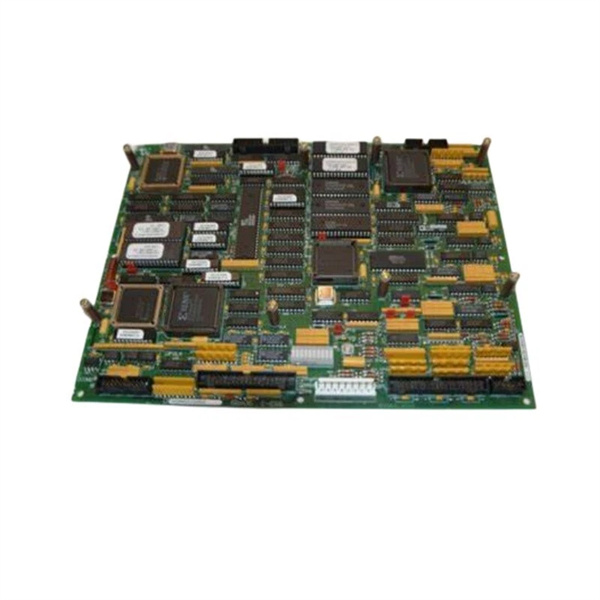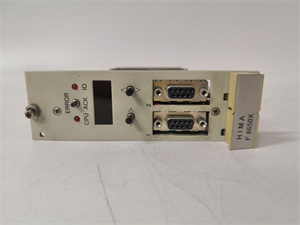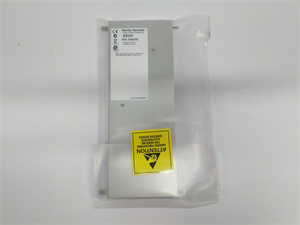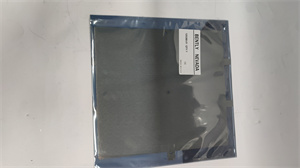Description
Detailed Parameter Table
| Parameter Name | Parameter Value |
| Product model | GE DS200LRPBG1A |
| Manufacturer | General Electric (GE) Industrial Automation |
| Product category | Advanced Logic Relay & Protection Module (Mark VIe Series Compatibility) |
| Input Configuration | 24 discrete digital inputs (24V DC sinking/sourcing); 4 analog inputs (4–20mA, 0–10V) |
| Output Configuration | 12 SPDT relays (2A @ 250V AC / 3A @ 30V DC); 2 analog outputs (4–20mA, proportional control) |
| Protection Functions | Overcurrent (0.1–20A, configurable), short-circuit, thermal overload, phase loss; Fault logging (last 50 events) |
| Communication Protocols | SPI (Mark VIe backplane, 1Mbps); RS-485 (Modbus RTU, 9600–115200 bps); Ethernet (Modbus TCP, optional via adapter) |
| Power Requirements | 24V DC (Mark VIe backplane); Current draw: 0.5A typical, 0.8A peak (relay activation) |
| Physical Dimensions (H×W×D) | 140mm × 105mm × 32mm (slot-mount); Weight: 240g |
| Operating Environment | Temperature: -30°C to +70°C (ambient); Humidity: 5%–95% RH (non-condensing) |
| Protection Ratings | ESD (±15kV contact); Overvoltage (up to 36V DC); Reverse polarity protection |
| Configuration Tool | GE Proficy Machine Edition v9.5+ (drag-and-drop logic, real-time diagnostics) |
| Certifications | CE, UL 508C, IEC 61010-1, ATEX Zone 2, IEC 61508 (SIL 2 Compatible) |
| Compatibility | GE Mark VIe Control Systems; Industrial motors, pumps, conveyors; GE DS200DMCAG1A (motor control), GE DS200DDTBG2A (I/O terminal) |

GE DS200LRPBG1A
Product introduction
GE DS200LRPBG1A is an advanced logic relay & protection module engineered by General Electric for high-demand industrial automation—building on the capabilities of its predecessor (GE DS200LRPAG1A) to deliver expanded I/O, enhanced protection, and flexible communication. As a core component of GE’s Mark VIe ecosystem, GE DS200LRPBG1A unifies three critical functions: customizable logic control, real-time equipment protection, and seamless data integration—eliminating the need for separate relay modules, logic controllers, and fault monitors in control cabinets.
In automation systems, GE DS200LRPBG1A acts as a “central command hub” for electromechanical devices like high-power motors or complex conveyor lines. For example, it uses 24 digital inputs to monitor safety interlocks and sensor data, executes preprogrammed logic (e.g., sequential startup of pumps), and activates 12 relays to control equipment or trigger alarms. Its analog inputs (4–20mA) also enable it to monitor variables like motor temperature or pressure, adding a layer of protection beyond basic discrete sensing.
What sets GE DS200LRPBG1A apart is its scalability: it handles larger I/O loads than entry-level models, supports optional Ethernet communication, and logs the last 50 fault events for root-cause analysis—making it ideal for mid-to-large industrial systems (e.g., power plant auxiliaries, automotive assembly lines) where downtime costs can exceed $10,000 per hour.
Core advantages and technical highlights
Expanded I/O for Complex Systems: GE DS200LRPBG1A’s 24 digital inputs and 12 relays (vs. 16/8 in GE DS200LRPAG1A) support more devices per module, reducing cabinet space by 40% in multi-equipment setups. In a beverage bottling plant, for instance, it monitors 18 sensors (bottle position, cap presence, conveyor speed) via digital inputs and controls 10 valves/motors via relays—all in one unit. The 4 analog inputs also let it track filler pressure (4–20mA signal) and adjust valve opening via analog outputs, ensuring consistent fill levels without additional control modules.
Multi-Layer Protection with Fault Logging: Unlike basic relays that only trip on overcurrent, GE DS200LRPBG1A offers phase loss, thermal overload, and short-circuit protection—critical for high-value equipment like 100HP motors. If a motor’s phase voltage drops (indicating a wiring fault), the module trips in <150ms to prevent burnout. It also logs the last 50 faults (timestamp, fault type, input values), allowing technicians to diagnose issues like “intermittent phase loss during peak load” instead of replacing parts blindly. In a mining operation, this logging reduced troubleshooting time for a conveyor failure from 8 hours to 45 minutes.
Flexible Communication for Integrated Systems: GE DS200LRPBG1A supports SPI (for Mark VIe backplane) and RS-485 (Modbus RTU), with an optional Ethernet adapter for Modbus TCP—enabling integration with both legacy and modern SCADA systems. In a wastewater treatment plant, it sends real-time relay status and fault data to the Mark VIe HMI via SPI, while using Modbus RTU to share pressure sensor data with a third-party pump controller. This compatibility avoids costly system overhauls and ensures GE DS200LRPBG1A fits into mixed-vendor automation environments.
Typical application scenarios
GE DS200LRPBG1A is a workhorse in a 600MW coal-fired power plant’s auxiliary control system, where it manages 8 boiler feedwater pumps. The module uses 20 digital inputs to monitor pump status (run/stop, bearing temperature alarms, suction pressure switches) and 2 analog inputs to track motor current (4–20mA from current transducers). Its logic program ensures pumps start in sequence (to avoid voltage spikes) and shuts down any pump with current exceeding 15A (overload) or temperature above 85°C (thermal risk).
During a 2024 maintenance cycle, GE DS200LRPBG1A detected a phase loss in Pump 5, tripping the relay in 120ms and logging the fault with a timestamp and current values. Technicians used the fault log to identify a loose terminal in the motor starter—repairing it in 1 hour instead of replacing the entire pump. This prevented a 6-hour shutdown of the boiler system, saving the plant $60,000 in lost generation.
In an automotive assembly plant, GE DS200LRPBG1A controls a robotic welding cell’s safety system. It monitors 12 light curtains and emergency stops via digital inputs, and activates 8 relays to disable welding power, lock cell doors, and sound alarms if a worker enters the zone. The analog inputs track welding current (4–20mA), triggering a warning if it deviates from 10–12mA—ensuring weld quality and preventing equipment damage.
Related model recommendations
GE DS200LRPAG1A: Entry-level variant of GE DS200LRPBG1A (16 inputs/8 relays, no analog I/O); ideal for simple systems like standalone pumps—GE DS200LRPBG1A is the upgrade for complex setups.
GE IC698CPE040-FJGE: Mark VIe CPU that communicates with GE DS200LRPBG1A via SPI; processes logic commands and displays real-time data on the HMI.
GE DS200DMCAG1A: Digital motor control board that pairs with GE DS200LRPBG1A; GE DS200LRPBG1A provides overcurrent protection, while GE DS200DMCAG1A regulates motor speed.
GE DS200DDTBG2A: Digital I/O terminal board that expands GE DS200LRPBG1A’s wiring capacity; organizes field connections and adds surge protection for inputs.
GE DS200EXPSG1A: 24V DC power supply module that delivers stable power to GE DS200LRPBG1A; ensures consistent relay performance during voltage fluctuations.
GE IS420YDIAS1B: Mark VIe analog input module that works with GE DS200LRPBG1A; adds 16 more analog channels for monitoring additional variables (e.g., flow, level).
GE Proficy Machine Edition v10.0: Configuration software for GE DS200LRPBG1A; enables drag-and-drop logic programming and fault log analysis.
GE Ethernet Adapter (IC698ENET001): Optional accessory for GE DS200LRPBG1A; adds Modbus TCP communication for integration with enterprise SCADA systems.
Installation, commissioning and maintenance instructions
Installation preparation: Before installing GE DS200LRPBG1A, confirm compatibility with the Mark VIe chassis and target equipment (e.g., motors, sensors). Ensure the environment meets -30°C to +70°C and 5%–95% RH (non-condensing). Required tools: torque screwdriver (0.5–0.8 N·m), wire strippers (22–14 AWG), ESD-safe gloves, multimeter, and Ethernet cable (if using optional adapter). Safety precautions: Power off the Mark VIe system and apply lockout/tagout. Mount GE DS200LRPBG1A in the chassis slot, secure with M4 screws, and connect power (24V DC) and I/O wires—use shielded cable for analog inputs to minimize EMI.
Maintenance suggestions: For daily operation, check GE DS200LRPBG1A’s LEDs (green = normal, red = fault, amber = warning) via the Mark VIe HMI. Every 3 months, inspect relay contacts for arcing (signs of wear) and retorque terminal screws to 0.6 N·m. Download fault logs monthly to identify recurring issues (e.g., frequent overcurrent on a specific motor). Test protection functions annually by simulating a phase loss or overcurrent—confirm the module trips within 150ms. If a relay fails, replace GE DS200LRPBG1A with a GE-approved spare; third-party modules may not match Mark VIe’s communication protocols or protection speed.
Service and guarantee commitment
GE DS200LRPBG1A is backed by a 48-month manufacturer’s warranty from GE, covering defects in materials, workmanship, and performance under normal industrial use (per UL 508C and IEC 61508 standards). If GE DS200LRPBG1A fails within the warranty period, GE provides a “rapid swap” service—pre-tested replacement modules are shipped within 48 hours for priority customers (e.g., power plants, automotive facilities) to minimize downtime.
GE offers 24/7 global technical support for GE DS200LRPBG1A, with specialists available via email or online portal to assist with logic programming, fault troubleshooting, or Ethernet integration. Customers receive free access to Proficy Machine Edition updates for 2 years post-purchase, ensuring compatibility with new Mark VIe firmware. For enhanced reliability, GE’s Industrial Services team provides annual on-site inspections—verifying relay response time, analog input accuracy, and communication links—reflecting GE’s commitment to keeping critical industrial systems safe and operational.
If you need to refine details—such as emphasizing its compatibility with specific industry standards (e.g., ISO 13849 for functional safety) or adding application notes for hazardous environments (ATEX Zone 1 compliance)—feel free to share more context. I can also expand on the module’s logic programming capabilities (e.g., support for ladder logic or function blocks) or adjust related model recommendations to align with your target use case (e.g., renewable energy, marine automation).




